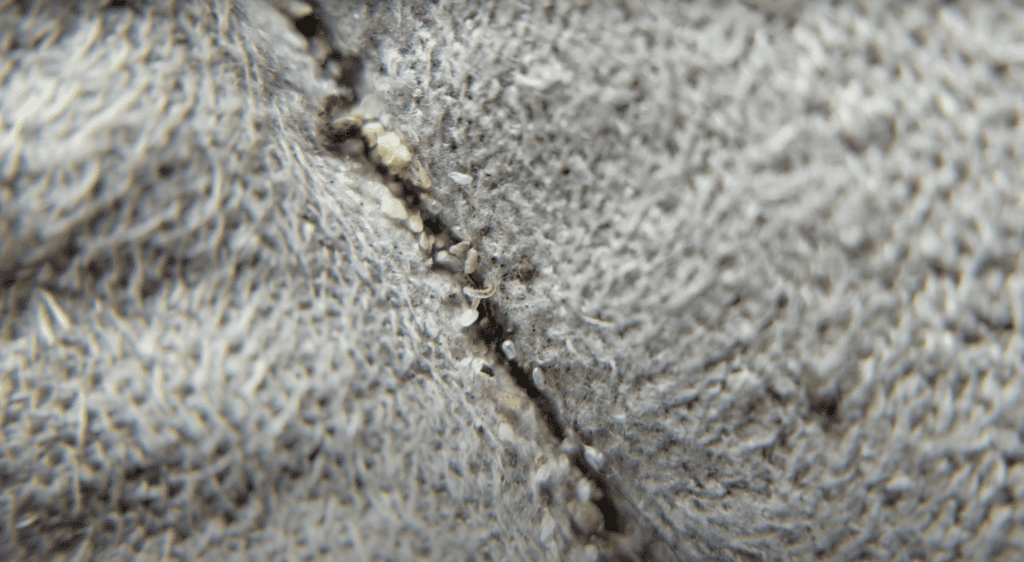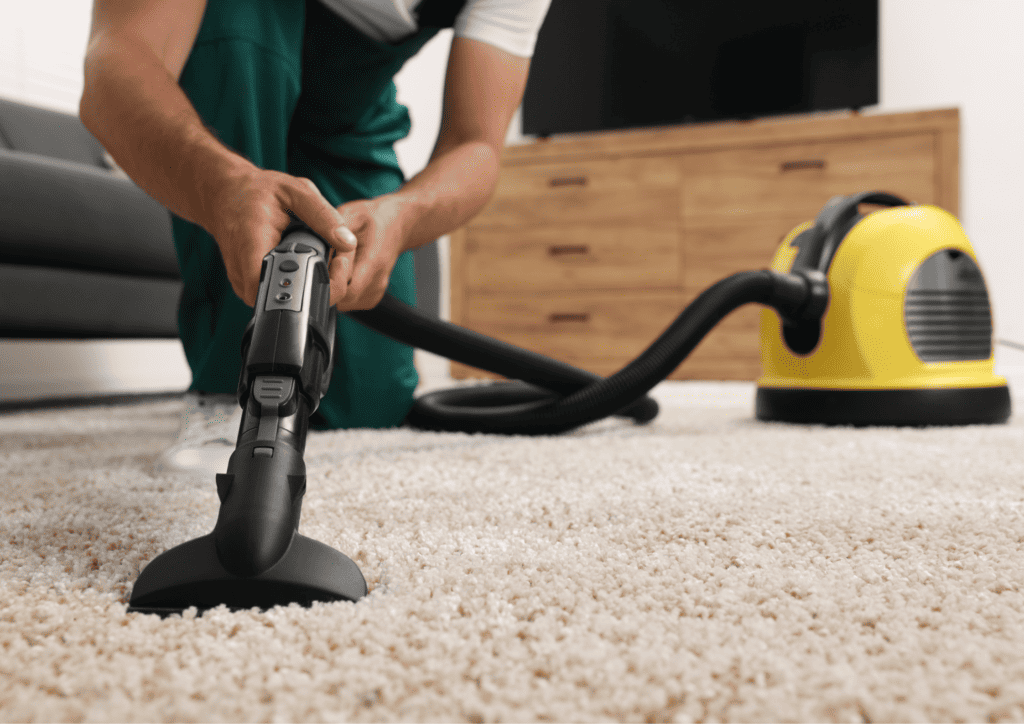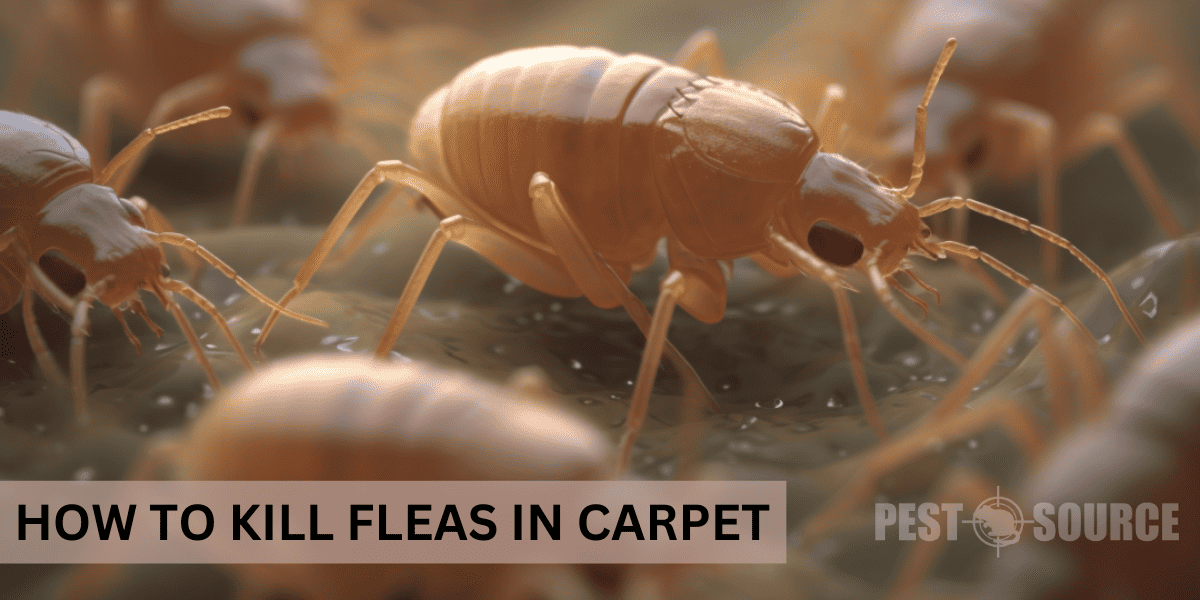Fleas have a knack for surviving in various conditions, and the fibers of carpets provide them with a perfect hiding place and breeding ground. Our comprehensive guide will provide insight into understanding these pesky invaders, their life cycle within the confines of your carpet, and importantly, how to kill fleas in carpet effectively.
We will explore a range of methods, from common treatments to natural alternatives, and preventative measures to keep these pests at bay. For households with pets, we will also delve into safe treatments that won’t compromise the health of your beloved companions.
Why is it Important to Eliminate Fleas from Carpets?
Understanding the impact of fleas on both pets and humans highlights the importance of eliminating these pests from carpets. The table below outlines key symptoms experienced by each, emphasizing the necessity for prompt flea control measures.
| Symptom | Affects | Description |
|---|---|---|
| Itching | Pets | Frequent scratching or biting of skin |
| Allergies | Pets | Skin inflammation, potential for secondary infections |
| Tapeworms | Pets | Intestinal parasite transmitted by fleas, visible in pet feces |
| Redness | Humans | Skin irritation and inflammation after flea bites |
| Allergic Reactions | Humans | Severe itching, hives, or swelling in response to flea bites |
Can Fleas Live and Breed in Carpets?
Yes, fleas can live and breed in carpets. Carpets provide an ideal environment for fleas to thrive, as they offer warmth, shelter, and easy access to their preferred hosts: your pets. The thick fibers of carpets also make it difficult for you to spot and remove them, allowing the infestation to grow and spread.
Understanding Fleas in Carpets
What are the Signs of Flea Infestation in Carpets?

There are several signs that can indicate a flea infestation in your carpets:
- Flea dirt: Flea dirt, or flea feces, looks like small black specks or pepper-like particles. You may notice these on your carpet, pet bedding, or even on your pet’s fur.
- Adult fleas: You might spot adult fleas hopping on your carpet, especially when you walk on it and disturb their hiding spots.
- Itching and scratching: If your pets are constantly itching and scratching, it could be a sign of fleas in your home. Humans may also experience bites, which can result in small, red, itchy bumps.
- Flea eggs and larvae: Flea eggs are tiny, white, and difficult to see, while larvae are small, worm-like creatures. You might find them in the fibers of your carpet, amidst flea dirt.
How do Fleas End Up in Carpets?
Fleas can enter your home in various ways. The most common way is by hitching a ride on your pets or even on you. Fleas can hop onto your clothing or shoes and be brought inside. Additionally, flea eggs, larvae, or pupae can be carried into your home via other animals, such as rodents, or on items like second-hand furniture or rugs.
Can Fleas Live in Any Type of Carpet?

Fleas can live in various types of carpets, but they tend to prefer thicker, plush carpets with more fibers to hide in. However, don’t assume that a thinner carpet or hard flooring is immune to infestation. Fleas can still find hiding spots in the seams, cracks, and edges of these surfaces.
How Long Can Fleas Survive in Carpets?
Fleas can survive in carpets for quite some time, depending on the conditions. Flea eggs can hatch within 2-14 days, and larvae can live for up to 18 days. Pupae can remain dormant for several months or even up to a year, waiting for the right conditions to emerge as adult fleas. Adult fleas typically live for 2-3 months. Keep in mind that factors such as temperature, humidity, and the availability of hosts can influence their lifespan.
To effectively eliminate fleas from your carpets, it’s essential to address all stages of their life cycle. Thorough vacuuming, steam cleaning, and the use of flea control products can help you tackle this pesky problem and prevent future infestations.
The Flea Life Cycle in Carpets
Understanding the flea life cycle is crucial for effectively eliminating these pests from your carpets. The flea life cycle consists of four stages: egg, larva, pupa, and adult. By learning about each stage and how they occur in carpets, you can target your flea control efforts more effectively.
How does the flea life cycle occur in carpets?
- Egg stage: The life cycle begins when adult fleas lay eggs on their host, which is usually a pet like a dog or cat. These tiny, white eggs easily fall off the host and onto surfaces like carpets, where they are hidden among the fibers. Flea eggs make up about 50% of the total flea population in a home.
- Larva stage: In about 2-14 days, the eggs hatch into larvae. These small, worm-like creatures can burrow deep into carpet fibers, making them difficult to spot and remove. They feed on organic debris like pet hair, dead skin cells, and adult flea feces. Larvae make up around 35% of the flea population in your home.
- Pupa stage: The larvae then spin protective cocoons around themselves, entering the pupa stage. These cocoons are sticky and can easily blend with the carpet, making them hard to find. The pupae can remain dormant for weeks, even months, before emerging as adult fleas when they sense vibrations or warmth, indicating a suitable host is nearby. Pupae account for approximately 10% of the total flea population.
- Adult stage: Once the adult fleas emerge from their cocoons, they immediately seek a host to feed on. Adult fleas can jump as high as 7 inches vertically, allowing them to easily latch onto passing pets or humans. Adult fleas make up the remaining 5% of the flea population, but since they’re the most visible, they may seem more numerous.
Why is it important to understand the flea life cycle when trying to eliminate them from carpets?
Knowing the flea life cycle is essential when dealing with an infestation, as it helps you target each stage more effectively. For instance, vacuuming regularly will help remove eggs, larvae, and adult fleas from carpets.
However, vacuuming alone won’t be enough to eliminate pupae, which require specific treatment methods like steam cleaning or using insect growth regulators (IGRs).
Being aware of the flea life cycle can also prevent re-infestation. For example, if you only treat adult fleas without addressing the eggs, larvae, and pupae hidden in your carpets, you’ll likely experience a resurgence as the remaining fleas mature and reproduce.
Methods for Killing Fleas in Carpets
Common Methods to Kill Fleas in Carpets
To effectively rid your carpets of fleas, several proven methods can be employed, each with its own set of advantages and ideal applications. Below is a table detailing common methods for flea eradication in carpets, including descriptions, pros, cons, and the best use cases for each method.
| Method | Description | Pros | Cons | Best Use Case |
|---|---|---|---|---|
| Vacuuming | Mechanical removal of fleas, eggs, and larvae from carpet fibers. | Non-toxic, immediately removes a significant percentage of fleas. | May not kill all life stages, especially pupae. | Regular maintenance and immediate reduction of flea population. |
| Flea Sprays and Powders | Chemical treatments applied directly to carpets to kill fleas at all life stages. | Targets fleas at all life stages, can offer residual protection. | Chemicals may pose risks to pets and humans if not used properly. | Severe infestations where chemical intervention is necessary. |
| Steam Cleaning | Use of hot steam to kill fleas, eggs, and larvae by exposure to high temperatures. | Chemical-free, effective against all life stages of fleas. | Requires equipment, may not be suitable for all types of carpets. | Periodic deep cleaning, especially in homes with pets and children. |
Before reaching for insecticides in the battle against fleas, vacuuming emerges as a powerful mechanical control method. The study “Pupation site selection of cat fleas (Siphonaptera: Pulicidae) in various carpet types and its influence on insecticide efficacy,” published in Veterinary Entomology, underscores the effectiveness of this simple tool. By thoroughly vacuuming, homeowners can remove a substantial portion of the flea population—including eggs, larvae, and adults—thereby enhancing the overall impact of subsequent insecticide treatments.
Killing Flea Eggs and Larvae in Carpets
Flea eggs and larvae are often difficult to eliminate from carpets because they can hide deep within the fibers. To kill flea eggs and larvae, you can use a combination of vacuuming, carpet treatments, and steam cleaning. Vacuuming can help remove eggs and larvae from the surface, while carpet treatments with insect growth regulators (IGRs) can prevent the development of flea larvae and pupae. Steam cleaning will expose the eggs and larvae to high temperatures, effectively killing them.
Fastest Ways to Kill Fleas in Carpets

The fastest way to kill fleas in carpets is to use a combination of vacuuming and targeted treatments. Vacuum your carpets thoroughly, paying particular attention to areas where your pets frequently rest. Follow this with a flea spray or powder treatment, which will target fleas in all life stages. Finally, consider steam cleaning your carpets to eliminate any remaining fleas, eggs, or larvae.
Treating Carpets for Fleas with Flea Sprays and Powders

Flea sprays and powders are effective methods for treating carpets infested with fleas. Choose a product specifically designed for carpets and follow the manufacturer’s instructions for application. Make sure to treat all carpeted areas in your home, as fleas can migrate from one room to another. Keep in mind that you may need to reapply the treatment after a couple of weeks to ensure all fleas, eggs, and larvae have been eliminated.
Carpet Cleaning for Flea Control

Carpet cleaning can help kill fleas by removing them from the carpet fibers and exposing them to high temperatures or chemicals. Steam cleaning is particularly effective, as the high temperatures can kill fleas in all life stages. Regular carpet cleaning, combined with other flea control methods, can help maintain a flea-free environment in your home.
Flea Carpet Shampoos and Their Effectiveness

Flea carpet shampoos can be an effective method for killing fleas in carpets. These shampoos contain insecticides that target fleas, eggs, and larvae. Read the product label carefully and follow the instructions for application. Keep in mind that you may need to use additional flea control methods, such as vacuuming and treating with IGRs, to fully eliminate fleas from your carpets.
Natural Methods to Eliminate Fleas from Carpets
Natural Methods for Killing Fleas in Carpets
For those seeking eco-friendly solutions to flea infestations, several natural methods for killing fleas in carpets offer effective alternatives to chemical treatments. The table below outlines various natural ingredients that can be used to eliminate fleas from carpets, detailing their mechanism of action, application tips, and safety considerations.
| Ingredient | Mechanism of Action | Application Tips | Safety Notes |
|---|---|---|---|
| Diatomaceous Earth | Dehydrates fleas by damaging their exoskeletons. | Sprinkle evenly over carpet, leave for 24 hours, vacuum thoroughly. | Use food-grade version and avoid inhaling powder. |
| Baking Soda | Dehydrates and kills fleas and their eggs. | Sprinkle on carpet, work into fibers with a brush, leave overnight, vacuum. | Non-toxic to pets and humans, ensure thorough vacuuming post-application. |
| Salt | Works similarly to baking soda, dehydrating fleas. | Apply generously to carpet, leave for 12-48 hours, vacuum thoroughly. | Generally safe, but keep pets and children away until vacuumed. |
These natural remedies provide a safer way to combat flea infestations, ensuring the health and safety of your household while effectively addressing the problem.
Removing Fleas from Carpet Naturally
To remove fleas from your carpet naturally, begin by vacuuming the carpet thoroughly to remove adult fleas, eggs, and larvae. Next, choose a natural method, such as diatomaceous earth, baking soda, or salt, and apply it to the carpet according to the instructions. Leave the treatment on the carpet for a few hours or overnight, and then vacuum again to remove the dead fleas and any remaining treatment residue. Repeat this process as needed until the flea infestation is eliminated.
Preventing Flea Infestations in Carpets
How can you prevent fleas from infesting your carpet?
Preventing fleas from infesting your carpet involves a combination of regular cleaning, pet care, and environmental control. Here are some steps to follow:
| Action | Frequency | Additional Tips |
|---|---|---|
| Vacuum regularly | At least twice a week | Focus on areas where pets spend most of their time. |
| Clean pet bedding | Every week | Use hot water to kill any fleas or eggs. |
| Use flea preventatives on pets | As recommended by veterinarian | Choose treatments suitable for your pet’s species and size. |
| Maintain a clean yard | Regular maintenance | Fleas can live in your yard, so be sure to keep it free of debris, tall grass, and leaf litter. Regularly mow the lawn and trim bushes to create an unfavorable environment for fleas. |
Can removing carpet prevent flea infestations?
Removing carpet can reduce the likelihood of flea infestations, as carpets provide an ideal environment for fleas to breed and hide. Hardwood, tile, or laminate flooring is less conducive to flea infestations, making it easier to spot and eliminate fleas.
What treatments can be used to prevent fleas in carpets?
There are several treatments available for preventing fleas in carpets, including:
- Insect growth regulators (IGRs): These are chemicals that inhibit the growth and development of flea larvae, preventing them from reaching adulthood. Apply IGRs to your carpet according to the manufacturer’s instructions.
- Flea powders and sprays: Use flea powders or sprays specifically formulated for carpets. Follow the label directions for application and safety precautions.
- Diatomaceous earth: This natural, non-toxic powder can be sprinkled on carpets to kill fleas by damaging their exoskeletons. Be sure to use food-grade diatomaceous earth and vacuum the area thoroughly after application.
Safe Flea Treatments for Carpets with Pets
What flea treatments are safe for carpets if you have pets?
When treating carpets for fleas with pets in the house, it’s essential to use pet-safe products. Some options include:
- Flea powders and sprays designed for use around pets: Look for products labeled as pet-safe and follow the manufacturer’s instructions for application.
- Natural treatments like diatomaceous earth: Food-grade diatomaceous earth is a non-toxic option that can be used safely around pets.
- Steam cleaning: Hot steam effectively kills fleas, eggs, and larvae without using any chemicals. Just ensure that your pets are kept away from the area during the cleaning process.
What precautions should be taken when treating carpets for fleas with pets in the house?
When treating carpets for fleas in a home with pets, follow these precautions:
- Keep pets away from treated areas until the product has dried or settled, as recommended by the manufacturer.
- Ventilate the area during and after treatment to minimize fumes and odors.
- Store flea treatment products out of reach of pets and children.
- Consult with your veterinarian about the best flea treatments for your pets to prevent re-infestation.
Can fleas live on hardwood floors?
What are the signs of flea infestation on hardwood floors?
Although fleas prefer carpets, they can also survive on hardwood floors. Signs of flea infestations on hardwood floors include:
- Flea dirt: Small, dark, pepper-like specks found on floors, pet bedding, or furniture.
- Adult fleas: You may spot adult fleas hopping on the floor or notice them on your pet’s fur or your own clothing.
- Itchy pets: If your pets are excessively scratching, biting, or licking themselves, it could be a sign of a flea infestation.
What are the methods to kill fleas on hardwood floors?
To kill fleas on hardwood floors, follow these steps:
- Vacuum thoroughly: Use a vacuum cleaner with a strong suction to remove adult fleas, eggs, and larvae.
- Mop the floors: Use a solution of warm water and mild detergent to mop the floors, paying close attention to corners, baseboards, and gaps between floorboards.
- Apply flea treatments: Use a pet-safe flea spray or powder specifically designed for hardwood floors, following the manufacturer’s instructions.
- Treat your pets: Administer veterinarian-approved flea treatments to your pets to prevent re-infestation.
How to prevent flea infestations on hardwood floors?
To prevent flea infestations on hardwood floors, maintain a regular cleaning schedule, treat your pets with flea preventatives, and keep your home environment clean and clutter-free.
Are there safe flea treatments for hardwood floors if you have pets?
Yes, there are pet-safe flea treatments for hardwood floors, such as:
- Pet-safe flea sprays and powders: Choose products specifically labeled as safe for use around pets and follow the manufacturer’s instructions.
- Diatomaceous earth: Food-grade diatomaceous earth is a non-toxic option for treating hardwood floors.
- Steam cleaning: Hot steam effectively kills fleas without using chemicals, making it a safe option for homes with pets. Just ensure that your pets are kept away from the area during the cleaning process.



